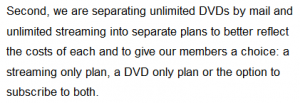 I must confess that I have a soft spot for Netflix. I worked there briefly eons ago when the company was in its infancy and I had briefly toyed with joining the dark side and leaving consulting. 😉 Back then, Marc Randolph was CEO. I liked Marc. I liked the product. And I just knew the company would do well, and it did—something my husband likes to remind me of from time to time, since I didn’t stay long enough to vest.
I must confess that I have a soft spot for Netflix. I worked there briefly eons ago when the company was in its infancy and I had briefly toyed with joining the dark side and leaving consulting. 😉 Back then, Marc Randolph was CEO. I liked Marc. I liked the product. And I just knew the company would do well, and it did—something my husband likes to remind me of from time to time, since I didn’t stay long enough to vest.
So, given this fondness, I was sad to see Netflix make such a muck of things these past few months. Some say its arrogance. Some say its greed. Some say Netflix is just moving too fast. The latter is not new.
I get the need to “move at Internet speed,” but even back then I thought Netflix could benefit from a little more thought before public action. Now, it’s even more imperative, because they’re big and everything they do is noticeable. An interesting quote from Hastings in a New York Times blog post on the latest reversal, speaks to this moving too fast:
‘“Companies rarely die from moving too fast, and they frequently die from moving too slowly,’ Mr. Hastings wrote in a blog post that night. His implication then was that Netflix had to act aggressively to expand its fast-growing streaming service by severing its older, slower DVD-by-mail arm.
In a sentence that now seems like a bit of foreshadowing, Mr. Hastings also wrote, ‘It is possible we are moving too fast — it is hard to say.’”
However…whether Netflix is moving too fast or not really isn’t what’s causing their reputation problems. Their communication style is.
Communication Breakdown # 1: Being Less Than Forthright
On the surface, the pricing increase wasn’t out of sync: $7.99 per month for unlimited DVDs, one out at a time, or $11.99 to have two out at a time, while streaming would be $7.99 per month. Blockbuster is $11.99 for one, $16.99 for two, and $19.99 for three.
Previously, streaming and unlimited DVDs (one at a time) combined was $9.99, so $15.98 for both is a big percentage increase, if not a huge amount of money on its own. However, at least one satellite provider that I know (who will remain nameless) charges $5.99 per pay-per-view movie, so $15.98 for unlimited streaming and DVDs sounds like a steal.
Sure, for some it’s too much. And they will, as expected, drop the service in favor of more affordable options, like Redbox, even if less convenient. But why this intense, over-the-top backlash?
Quite simple: Netflix said the pricing change was for their customers, when it was obvious it wasn’t. To a large percentage of Netflix subscribers, the post on the Netflix blog was nothing but marketing fluff. And it made them angry.
Communication lesson: Be up front. Don’t package any messaging—especially in social media—in fluff designed to make it look like you’re doing your customers a favor. They may not like the decision you made, but they won’t ever get as mad as they will when you try to pull the wool over their eyes. It increases the irritation factor exponentially.
Communication Breakdown # 2: Ignoring the Conversation
Other than the blog posts announcing the price changes in July, apologizing and announcing Qwikster in September, and announcing that Qwikster was a no-go in October (and similar emails to customers and announcements on Facebook and Twitter), Netflix has pretty much remained silent on these topics at all other times. Bad idea.
This deafening silence doesn’t appear limited to the current communication crisis either. On their Facebook wall, for example, I didn’t see any response from them to any follower posts in the last 72 hours. Positive comments, complaints, queries, customer service questions—other followers commented, but Netflix was missing from the conversation. Again, bad idea—and a big no-no in the social world.
Communication lesson: Don’t ignore the conversation. Let me repeat it in case it wasn’t clear: DON’T IGNORE THE CONVERSATION. Embrace it and let it be an opportunity to strut your customer service responsiveness.
Communication Breakdown # 3: Not Tapping the Pulse of Customers First
One gets the feeling that Netflix communicated very little with customers prior to the announcement in order to understand how the changes would be received. If that’s the case, it’s not a good idea. Consumers are used to having a say and don’t hesitate to voice their displeasure, making gaining customer insight prior to implementing big changes a must in the social age.
Communication lesson: Test the waters before making big changes—and test them well. My friend and talented colleague Jennifer Berkley Jackson of The Insight Advantage is very good at helping companies do just that.
Communication Breakdown # 4: Waiting Two Months to Apologize…
…and wrapping that apology with an announcement that “Hey, we’re now breaking these two separately priced services into two companies and websites.”
Reed’s apology started off on the right foot, “I messed up.” He even offered an explanation, although it didn’t come across entirely as a mea culpa and many felt it a backhanded apology. But he made it worse by tacking on another “big” announcement at the end. It was like Netflix learned nothing from the fiasco two months ago. And what was the community response? The exact same thing as occurred with the pricing announcement.
Communication lesson: Fess up. Right away. Don’t wait, because you think it will blow over. In today’s social world, it likely won’t go away. If anything, it will gain momentum, because customers will just get angrier over being ignored and your perceived arrogance. So, take a lesson from the politicians—especially since they seem incapable of learning it—if you fess up and apologize, things will go a lot smoother.
And don’t tie your apology to another announcement, as any genuine intentions in the apology will be colored—from your audience’s perspective—by the “thing” you’re announcing, unless, of course, it’s undoing whatever upset them in the first place.
There are other breakdowns and lessons to be learned from Netflix’s pain, but who wants to read a blog post that long? This one is long enough. I will, however, go over a few of the social media no-nos Netflix committed throughout this almost four-month-long communication spiral in my next blog post.




